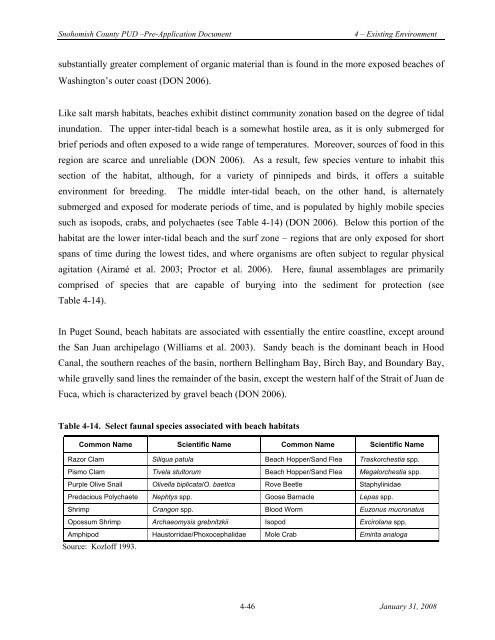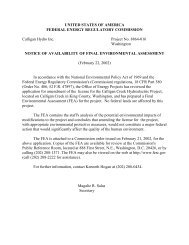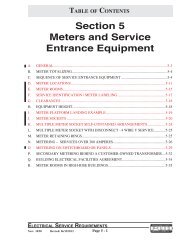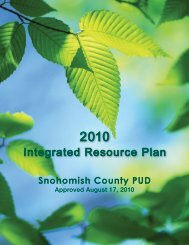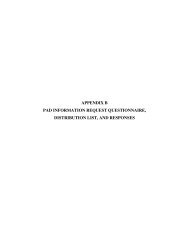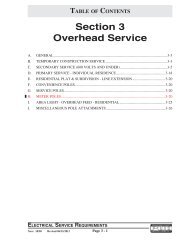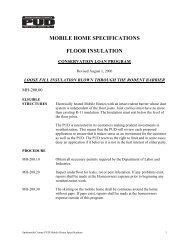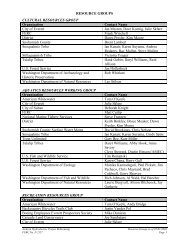Tidal_PAD_V1_Sec4.pdf - Snohomish County PUD
Tidal_PAD_V1_Sec4.pdf - Snohomish County PUD
Tidal_PAD_V1_Sec4.pdf - Snohomish County PUD
You also want an ePaper? Increase the reach of your titles
YUMPU automatically turns print PDFs into web optimized ePapers that Google loves.
<strong>Snohomish</strong> <strong>County</strong> <strong>PUD</strong> –Pre-Application Document<br />
4 – Existing Environment<br />
substantially greater complement of organic material than is found in the more exposed beaches of<br />
Washington’s outer coast (DON 2006).<br />
Like salt marsh habitats, beaches exhibit distinct community zonation based on the degree of tidal<br />
inundation. The upper inter-tidal beach is a somewhat hostile area, as it is only submerged for<br />
brief periods and often exposed to a wide range of temperatures. Moreover, sources of food in this<br />
region are scarce and unreliable (DON 2006). As a result, few species venture to inhabit this<br />
section of the habitat, although, for a variety of pinnipeds and birds, it offers a suitable<br />
environment for breeding. The middle inter-tidal beach, on the other hand, is alternately<br />
submerged and exposed for moderate periods of time, and is populated by highly mobile species<br />
such as isopods, crabs, and polychaetes (see Table 4-14) (DON 2006). Below this portion of the<br />
habitat are the lower inter-tidal beach and the surf zone – regions that are only exposed for short<br />
spans of time during the lowest tides, and where organisms are often subject to regular physical<br />
agitation (Airamé et al. 2003; Proctor et al. 2006). Here, faunal assemblages are primarily<br />
comprised of species that are capable of burying into the sediment for protection (see<br />
Table 4-14).<br />
In Puget Sound, beach habitats are associated with essentially the entire coastline, except around<br />
the San Juan archipelago (Williams et al. 2003). Sandy beach is the dominant beach in Hood<br />
Canal, the southern reaches of the basin, northern Bellingham Bay, Birch Bay, and Boundary Bay,<br />
while gravelly sand lines the remainder of the basin, except the western half of the Strait of Juan de<br />
Fuca, which is characterized by gravel beach (DON 2006).<br />
Table 4-14. Select faunal species associated with beach habitats<br />
Common Name Scientific Name Common Name Scientific Name<br />
Razor Clam Siliqua patula Beach Hopper/Sand Flea Traskorchestia spp.<br />
Pismo Clam Tivela stultorum Beach Hopper/Sand Flea Megalorchestia spp.<br />
Purple Olive Snail Olivella biplicata/O. baetica Rove Beetle Staphylinidae<br />
Predacious Polychaete<br />
Nephtys spp.<br />
Goose Barnacle<br />
Lepas spp.<br />
Shrimp Crangon spp. Blood Worm Euzonus mucronatus<br />
Opossum Shrimp Archaeomysis grebnitzkii Isopod Excirolana spp.<br />
Amphipod Haustorridae/Phoxocephalidae Mole Crab Emirita analoga<br />
Source: Kozloff 1993.<br />
4-46 January 31, 2008


